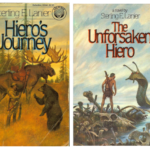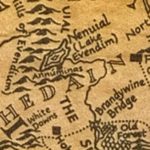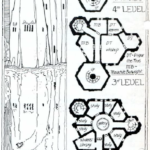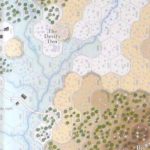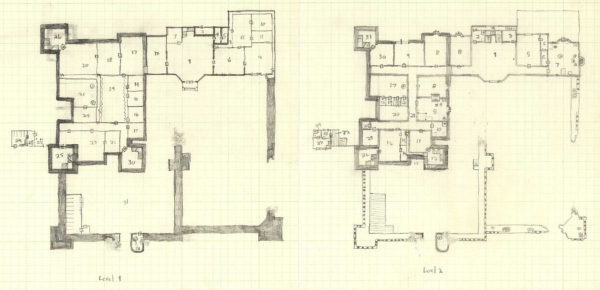One of the longest running campaigns I’ve ever run was a Gamma World game based on the original first edition rules. In building the world, I used not only elements from the setting sketched out in the book, but elements from other game settings like The Morrow Project and Aftermath along with ideas from film and fiction. The most direct lift was the territory controlled by the Eleveners, a direct lift from Hiero’s Journey by Sterling E. Lanier and its sequel, though the actual details of their society included elements from Miller’s A Canticle for Liebowitz and was a combination of Healers and Restorationists as presented as Cryptic Alliances in the setting. Lifewise, the Brotherhood of the Unclean became simply The Unclean as the dark side to the Restorationists with a healthy dose of other antagonists thrown in including, most predominantly, Radioactivists.
Page 4 of 6
The maps of Middle Earth have always held a special place with me, whether it’s been the original maps by J.R.R. Tolkien himself, the version by Pauline Baynes from the calendar that I owned once upon a time, or the detailed maps by Karen Wynn Fonstad that appeared in her Atlas of Middle Earth. The idea of a world with depth and history is always appealing and I must have explored every corner of the world, not only following the path of the Fellowship, but also the places mentioned in the stories or shown on the maps that were peripheral to the saga.
Of particular note was the lost kingdom of Arnor and the remains of its capital city, Annúminas, on the southern shore of Nenuial, also known as Lake Evendim. This is, without a doubt, my single most favorite place in Middle Earth. As the ruins of a once-great city, it barely merits a footnote in the story apart from being a special place to the Rangers of the North, the descendents of the northern Dúnedain.
Which brings us to Pete Fenlon and his work over a decade and a half working at Iron Crown Enterprises working on their Middle Earth roleplaying game and the numerous supplements detailing parts of the world, expanding on the works of Tolkien, and creating new adventures. Many of us were inspired by his work and have so many great memories of each and every map. The Pete Fenlon style has influenced not just gamers like myself, but other map designers, as well.
Continue reading
One of the most difficult things with maps, particularly in those for roleplaying games, is capturing three-dimensional spaces. Since the early days of computer games like Colossal Cave Adventure and various dungeon delves, the result is the flattening of complex structures onto two-dimensional planes.
My experiences as an early gamer were rather insular and even TSR’s Dwellers of the Forbidden City (I1) passed me by at the time, much like many of the works out of the UK including the Pellinore game setting. As a result, I think my first exposure to isometric maps were the ones from the Dragonlance adventures and those blew my mind.
Hex maps are a staple of games, a way of describing a chaotic surface in a way that facilitates play by abstracting that surface to a degree that’s easier and simpler than it would otherwise be. As an old-time gamer, I confess to a soft spot for hex maps, whether it’s the simplicity of the terrain as modelled in the original Panzer Blitz and Panzer Leader, or the use of hexagons to show distance in above-ground maps for roleplaying game settings like The World of Greyhawk (TSR) and The Wilderlands of High Adventure (Judge’s Guild).
At their best, hex maps combine an ease-of-use with a wealth of detail that makes them both functional as game maps while simultaneously conveying that functionality in a visually-pleasing fashion that makes clear what’s being represented.
By way of example, consider the Battle of Gettysburg and the challenges it presents to a wargame designer. How best to represent key areas like Devil’s Den, an area littered randomly with boulders and trees, and overlooked by Little Round Top? The somewhat unique character of the terrain gave the struggles in that area a different feel and something to be captured on a map as something more than a rough terrain hex. The same can be said for many unique features, either specific to a particular battlefield or to a theater of operations, be it the bocage of Normandy or the factories of Stalingrad, to name but a couple.
Which brings us to Redmond A. Simonsen, one of my absolute favorite map designers whose credits span a myriad genres of wargames. I’m not sure which of his maps I fell in love with first, but most span the same era (1977-1981, the heyday of Simulations Publications, Inc. (SPI)).
Decades ago, I used to draw maps. I’ve always enjoyed maps of imaginary places and I’ve drawn more than a few of my own. As much as I enjoyed drawing them, I really fell off in completing new maps or even in sketching out ideas.
For 2018, my goal is to rediscover my love of maps, to share the maps and artists who have inspired me, and to create more maps of my own along with the process from inception to completion.
Continue reading
Through the web and database version of mitosis, the development posts and professional content that used to reside here are now in a new location at a brand-new website. The new site, DavidBennettDev now exists as the professional counterpart to this site as I focus more on things like music and games here.
So if you’re looking for my posts on web development, Agile methodologies, coding, and data manipulation, then I encourage you to visit the new site. It’s shiny new from the top down, using Twitter Bootstrap and a bunch of new things that I didn’t care to add here. On the other hand, if you’re looking for my excursions into music, writing, games (of any stripe, be it computer, pen-and-paper, or board), genealogy, maps, and all those things that I find interesting, then you’ve come to the right place.
Coming soon is yet another site, this one focused on my family, my family tree, and things of interest to history and genealogy buffs. Stay tuned for the launch of that site.
While I’m not a hard-core fan of the Halo video game series, I’ve certainly played my fair share of the franchise, read the books and more. While working on Crimson Skies XBox title, we had the privilege of looking at the controller scheme and played quite a bit of multiplayer LAN matches of the first Halo game as a break from the game we were developing (those of us who weren’t playing Battlefield 1942).
As a result, though, there’s a bit of bias in my enjoyment of the Forward Unto Dawn web series that’s prefacing the release of Halo 4. The series follows a group of cadets training to fight the insurrectionists right when the Covenant launches its first attacks. Seen from the eyes of these ordinary people, Orbital Drop Shock Troopers (ODSTs) are regarded with a certain degree of hero worship, but when we’re introduced to the Covenant and the appearance of a Spartan, we see them all in a different light. In particular, the Covenant Elites are rather terrifying and their appearance in the show makes for great drama.
Continue reading
When I was in China last year, I spent most of an afternoon wandering the city of Guangzhou exploring the neighborhood around Yuhu Lake, an area diametrically opposite to my intended destination. I set out from my hotel with a good idea of where I was headed and figured my destination, Yuexiu Park, was so large that there was no way I could miss it. It turns out, I was wrong.
The problems began when I discovered the map I had used to initially orient myself was inadequate for the task of displaying three dimensions. In particular, the area I was headed contained hills, a multi-tier highway, a pedestrian overpass, an elevated railway with a pedestrian underpass, roads running at angles to each other, few visible landmarks, and road signs in Chinese. I’ve since educated myself further on the last point (at least to the extent of knowing Xiaobei Lu translates as Little North Road), but that still would have only helped a little.
Continue reading
After some time running this site under Joomla! with the blog being handled by WordPress, I’ve finally switched over to only use WordPress. Although I like the features of a full-fledged content management system and Joomla! has some great features, it was both a little more heavy-weight than I needed and the maintenance tasks to keep it up-to-date were taking away from other work that I wanted to do. In particular, even though I’m using the excellent Now Reading Reloaded plugin to manage my library (after switching from the original Now Reading plugin), it’s no longer being updated and there are some features that I’d really like it to have. Unfortunately, the way the plugin is architected, I’ve come to conclusion that I’d be better off writing a new plugin, particularly if I wanted a less hacked-together way to store authors as separate entities in their own database table. My library has also grown to a size that I’d like to better be able to paginate results and other things like that.
Meanwhile, I’ve temporarily removed some pages, so if you’ve come looking for them, my apologies. I’ll be adding things back along with more things besides in the coming weeks. If you notice something missing and care to offer constructive feedback, I’d be happy to hear from you!
The flailing world economy has affected everything, nothing more than the things we take for granted like public parks and libraries. The King County Library System, of which my local library is part, faces chronic budget shortfalls, though they never seem as severe as the woes experienced by Seattle Public Libraries. The rhetoric and reasoning behind cutting back at libraries always seems to focus on the idea that libraries are a luxury or that needs to be run as a business. When we talk about the efficiency of libraries, we miss the point, since libraries are more than the sum of their parts.
Facing even more severe budgetary problems, many libraries in Britain are on the block for closure. For that reason, people like author Philip Pullman are speaking out about the short-sighted nature of the closures. In a recent speech by Mr. Pullman, he said, in part:
“It’s imported the worst excesses of market fundamentalism into the one arena that used to be safe from them, the one part of our public and social life that used to be free of the commercial pressure to win or to lose, to survive or to die, which is the very essence of the religion of the market. Like all fundamentalists who get their clammy hands on the levers of political power, the market fanatics are going to kill off every humane, life-enhancing, generous, imaginative and decent corner of our public life. I think that little by little we’re waking up to the truth about the market fanatics and their creed.”
“And you could go a little further back to the end of the nineteenth century and look at the ideas of “scientific managementâ€, as it was called, the idea of Frederick Taylor that you could get more work out of an employee by splitting up his job into tiny parts and timing how long it took to do each one, and so on – the transformation of human craftsmanship into mechanical mass production.”
He also speaks about the wonders of libraries, their place in society and much more. If you spend time at your local library, you know these things and the importance of libraries and the skilled staff who work in those places. But articulating that defense to someone who sees things only in terms of dollars, who doesn’t think they should be taxed for services they don’t use (a notion that ignores the interconnected nature of society and how funding for schools has an impact on crime rates or how parks affect overall quality of life – intangibles that don’t lend themselves to line items in a budget), is a difficult proposition. The way Mr. Pullman expresses his opposition to the idea that government needs to be run like a business resonates perfectly with my thoughts on the subject.
It was at my local library when I was young that I chanced upon a copy of the script to Monty Python and the Holy Grail, complete with scenes cut for reasons of length. Perhaps not life-changing at that age, but definitely one of the more memorable finds among the cornucopia of offerings that could be found at the Vashon Public Library. And though I use computers all the time and make my living building websites, I still visit the library with my daughter almost every week. Because the internet isn’t a place and a website isn’t a book and a library isn’t a business. A library is something unique and wonderful that can’t be replaced.
